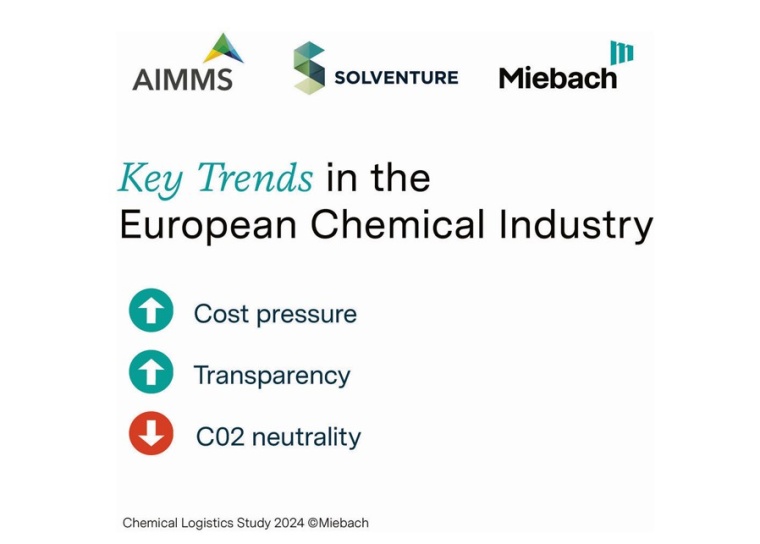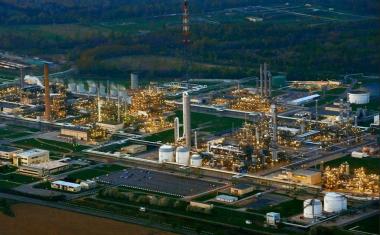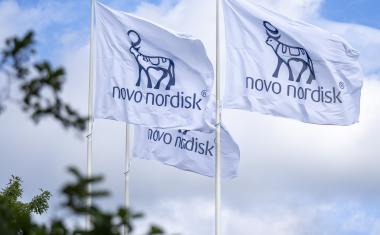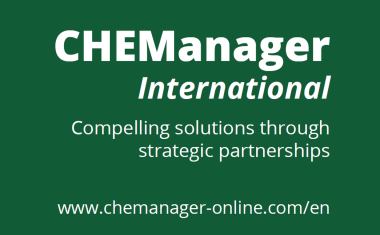Chemical Logistics Study 2024
A study on logistics in the chemical industry shows that there is a significant need to develop a more professional approach to supply chain and logistics planning and the use of digitalization and AI, but that the industry is currently struggling with limited resources and budget constraints.

It seems that the current tense economic situation in the chemical industry has come at an inopportune time — major challenges with a great need for action are currently being amplified by cost pressure and an overall economical downturn. But right now it is important to set the course for a successful restart after overcoming the current dip!
This is the summary of our findings from the 2024 Supply Chain and Logistics Chemical Study of Solventure, Aimms and Miebach, which deals with current key trends and challenges, the use of digitalization and AI, as well as how to plan in the European chemical industry.
What are the current trends and challenges in the chemical industry? This starting question has been broken down into a selection of possible trends and their significance from the participants’ point of view.
Cost Pressure more Important than CO2 Neutrality
Unsurprisingly, the participants of the 2024 Supply Chain and Logistics Chemical study rated “Increasing cost pressure on warehousing and transportation,” that means the cost pressure currently being felt everywhere, as currently the most important. This also reflects our view of the current perception in the market, with one cost-cutting program after another against the backdrop of dramatic slumps in sales on the one hand and hyperinflation in terms of energy and personnel costs on the other. However, “Transparency through enhanced communication and close dialogue” was rated almost as important and significant as the current cost pressure, followed by the “Diversification of supply chains in order to be able to operate flexibly with all modes of transport.” But the most surprising result has been that the “Industry ambitions to become carbon neutral” are currently only considered to play a subordinate role. Contrary to all public statements, this is considered to be the least important trend.
Industry not Well Equipped to Meet Current Challenges
Only regarding the topic of “Transparency through enhanced communication and close dialogue” around 50% respond that they are very well or well prepared, while around 1/3 each responded that they are well prepared for “Increasing cost pressure on warehousing and transportation” and “to align chemical supply chain logistics to customer- and product specifics and not to proceed according to one supply chain fits all.” The maturity level “Working on it,” i.e., companies are facing up to the issues without already having an answer ready, receives the most approval with regard to all the challenges mentioned. And some also have to admit that they are inadequately prepared or not prepared at all for one challenge or another.
Digitalization and the Use of AI Hardly Widespread Yet
Digitalization and the use of AI are the hottest topics at the moment and (almost) everyone is talking about them. But what about the actual spread of digitalization and AI applications in supply chain management and logistics? We asked and received sobering answers.
None of the participants in the study have a supply chain digital twin to date or are at least planning to implement one in 2024. The results regarding the use of a digital twin for warehousing and the use of control towers are almost identical. Robot process automation, big data analytics and predictive analytics have their first users, with others planning to follow in 2024 or 2025. And 2/3 of the participants are planning to use AI for inventory optimization from 2025 onwards — it remains to be seen whether this will actually be implemented to this extend.
Strategic, Tactical and Operational Planning
The third part of the study looks at how companies in the chemical industry plan at a strategic, tactical and operational level, who is involved and which instruments are used.
Strategic planning takes place every 2-3 years or on demand, only a few plan annually, e.g., in the area of production footprint or last mile distribution. However, many companies also responded that they only plan on demand. For the majority of participants, the internal organization is responsible for carrying out such planning, but >40% also use internal (16%) or external consultancies (25%). Excel is still the dominant planning tool, as is ERP for tactical and operational planning tasks. Specific professional software is rarely found.
To summarize, the study shows a significant demand to develop a more professional approach in supply chain & logistics planning and using digitalization and AI in the chemical industry, but the industry has currently to deal with limited resources and budget constraints. We will be more then interested if this situation will change once the business will pick up again.
Klaus-Peter Jung, Partner and Head of Industry for the Chemical Industry, Beverages and Logistics Service Providers, Miebach Group, Frankfurt am Main, Germany



















